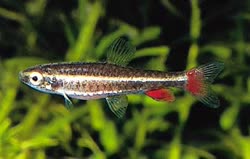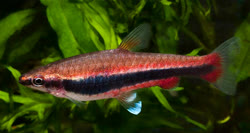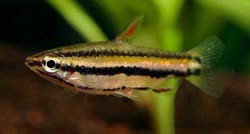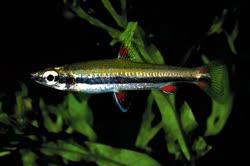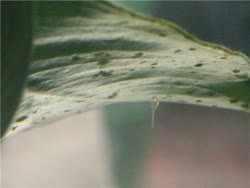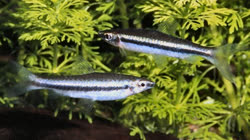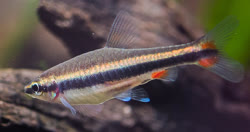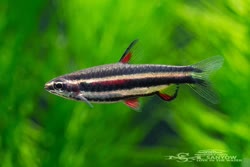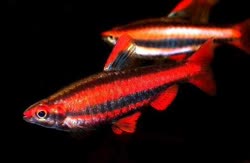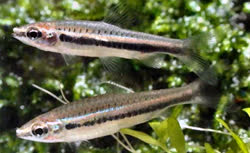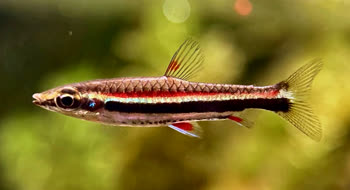|
Males of N. rubrocaudatus can be told apart from those of N. mortenthaleri by the fact that the red pigmentation in the rear half of the body is purplish and more uniform than in N. mortenthaleri which when not breeding only displays red colouration between the primary and secondary lateral stripes. Alan P. Vaissiere |
|
Prior to description this species was traded as Nannostomus sp. ‘purple’, N. cf. marginatus ‘red pencil II’, or N. sp. ‘coral red II’. It can be told apart from similar species by the following combination of characters, adapted from Zarske (2009): pronounced sexual dimorphism with adult males exhibiting bright red-purple pigmentation between the central, upper, and lower (primary, secondary and tertiary) dark lateral stripes; all three dark lateral stripes strong and distinctive; central (primary) lateral stripe in males extending ventrally to posterior half of anal-fin base; anterior part of dorsal-fin in males red; adipose-fin absent; males with modified, thickened anal-fin rays; 2 teeth on each maxillary bone. In live fish colour pattern is perhaps the most useful way to identify N. rubrocaudatus plus the closely-related N. marginatus and N. mortenthaleri. N. marginatus is immediately distinguished from the other two by the fact it lacks red pigmentation on the body in males, but N. mortenthaleri and N. rubrocaudatus are more easily-confused. Males of N. rubrocaudatus can be told apart from those of N. mortenthaleri by the fact that the red pigmentation in the rear half of the body is purplish and more uniform than in N. mortenthaleri which when not breeding only displays red colouration between the primary and secondary lateral stripes. In N. rubrocaudatus the anterior portion of the dorsal-fin is red and the distal portion hyaline, and the ventral fins are reddish proximally, hyaline distally, while in N. mortenthaleri there is a white blotch at the anterior base of the dorsal-fin and the distal part of the fin is red, and the ventral and anal fins are more-or-less entirely red. In females of N. rubrocaudatus the interspace between primary and secondary lateral stripes is silvery with a reddish stripe below the primary dark stripe in the rear of the body and a small red patch between the primary and tertiary stripes anterior to the anal-fin, while in N. mortenthaleri the entire area between primary and secondary stripes is reddish. As in males the ventral and anal fins are reddish proximally and hyaline distally in N. rubrocaudatus, more-or-less uniformly reddish in N. mortenthaleri. Don’t worry if your fish look different when you switch on the aquarium lights after dark or in the morning as like most Nannostomus species it assumes a different colour pattern at night, in this case the entire colour pattern paling considerably and the dark lateral stripes disappearing. This diurnal rhythm has been show to occur in blind specimens, suggesting it’s an automatic response that the fish cannot control. Alan P. Vaissiere |
